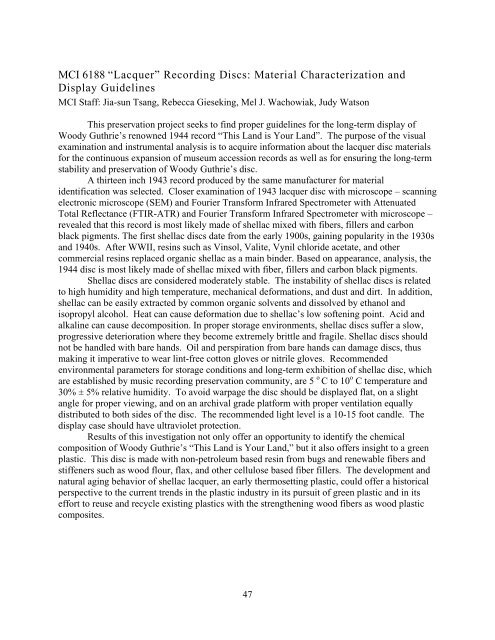MCI Project Summaries 2008 - Smithsonian Institution
MCI Project Summaries 2008 - Smithsonian Institution
MCI Project Summaries 2008 - Smithsonian Institution
Create successful ePaper yourself
Turn your PDF publications into a flip-book with our unique Google optimized e-Paper software.
<strong>MCI</strong> 6188 “Lacquer” Recording Discs: Material Characterization and<br />
Display Guidelines<br />
<strong>MCI</strong> Staff: Jia-sun Tsang, Rebecca Gieseking, Mel J. Wachowiak, Judy Watson<br />
This preservation project seeks to find proper guidelines for the long-term display of<br />
Woody Guthrie’s renowned 1944 record “This Land is Your Land”. The purpose of the visual<br />
examination and instrumental analysis is to acquire information about the lacquer disc materials<br />
for the continuous expansion of museum accession records as well as for ensuring the long-term<br />
stability and preservation of Woody Guthrie’s disc.<br />
A thirteen inch 1943 record produced by the same manufacturer for material<br />
identification was selected. Closer examination of 1943 lacquer disc with microscope – scanning<br />
electronic microscope (SEM) and Fourier Transform Infrared Spectrometer with Attenuated<br />
Total Reflectance (FTIR-ATR) and Fourier Transform Infrared Spectrometer with microscope –<br />
revealed that this record is most likely made of shellac mixed with fibers, fillers and carbon<br />
black pigments. The first shellac discs date from the early 1900s, gaining popularity in the 1930s<br />
and 1940s. After WWII, resins such as Vinsol, Valite, Vynil chloride acetate, and other<br />
commercial resins replaced organic shellac as a main binder. Based on appearance, analysis, the<br />
1944 disc is most likely made of shellac mixed with fiber, fillers and carbon black pigments.<br />
Shellac discs are considered moderately stable. The instability of shellac discs is related<br />
to high humidity and high temperature, mechanical deformations, and dust and dirt. In addition,<br />
shellac can be easily extracted by common organic solvents and dissolved by ethanol and<br />
isopropyl alcohol. Heat can cause deformation due to shellac’s low softening point. Acid and<br />
alkaline can cause decomposition. In proper storage environments, shellac discs suffer a slow,<br />
progressive deterioration where they become extremely brittle and fragile. Shellac discs should<br />
not be handled with bare hands. Oil and perspiration from bare hands can damage discs, thus<br />
making it imperative to wear lint-free cotton gloves or nitrile gloves. Recommended<br />
environmental parameters for storage conditions and long-term exhibition of shellac disc, which<br />
are established by music recording preservation community, are 5 o C to 10 o C temperature and<br />
30% ± 5% relative humidity. To avoid warpage the disc should be displayed flat, on a slight<br />
angle for proper viewing, and on an archival grade platform with proper ventilation equally<br />
distributed to both sides of the disc. The recommended light level is a 10-15 foot candle. The<br />
display case should have ultraviolet protection.<br />
Results of this investigation not only offer an opportunity to identify the chemical<br />
composition of Woody Guthrie’s “This Land is Your Land,” but it also offers insight to a green<br />
plastic. This disc is made with non-petroleum based resin from bugs and renewable fibers and<br />
stiffeners such as wood flour, flax, and other cellulose based fiber fillers. The development and<br />
natural aging behavior of shellac lacquer, an early thermosetting plastic, could offer a historical<br />
perspective to the current trends in the plastic industry in its pursuit of green plastic and in its<br />
effort to reuse and recycle existing plastics with the strengthening wood fibers as wood plastic<br />
composites.<br />
47

















